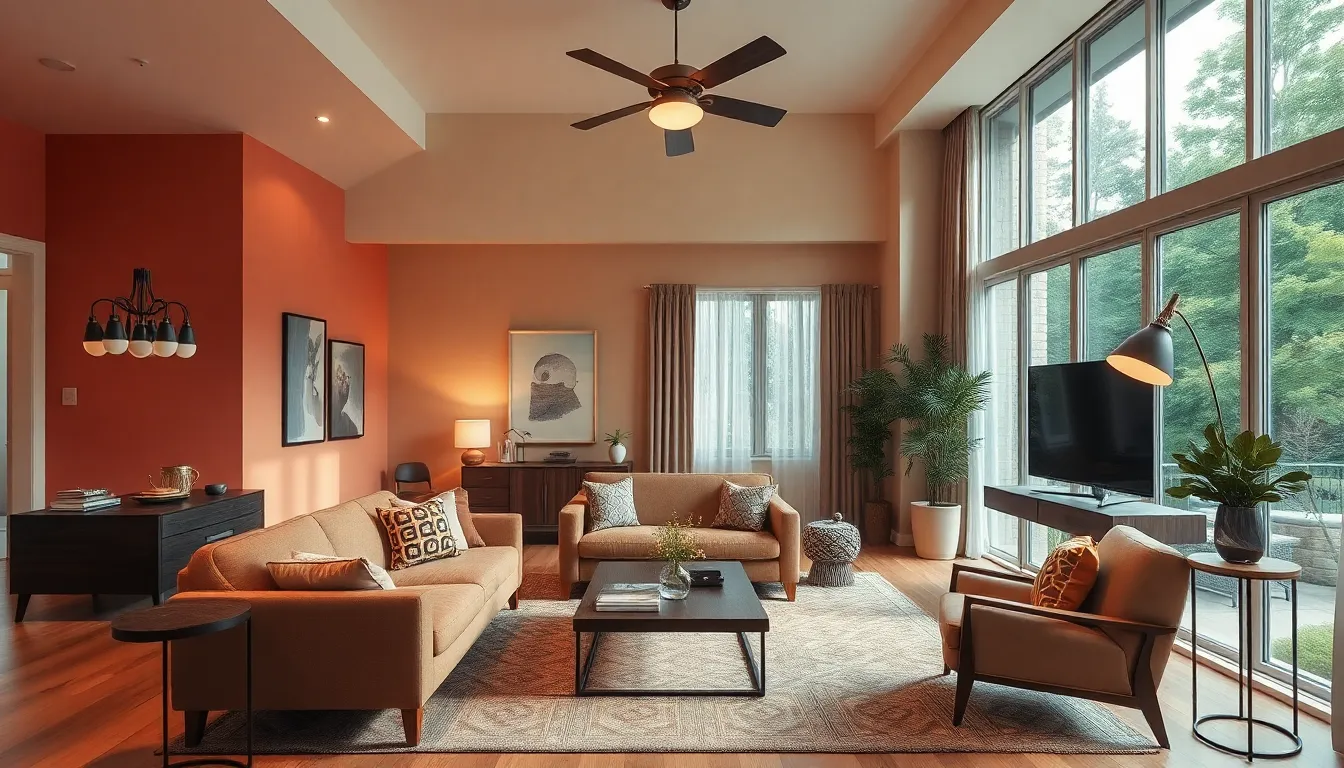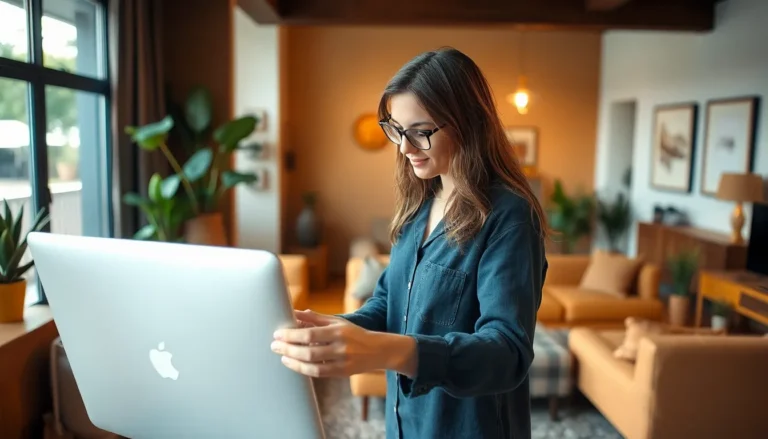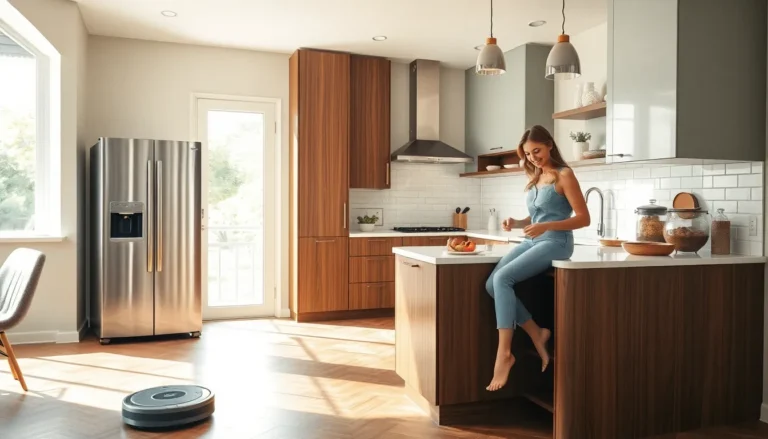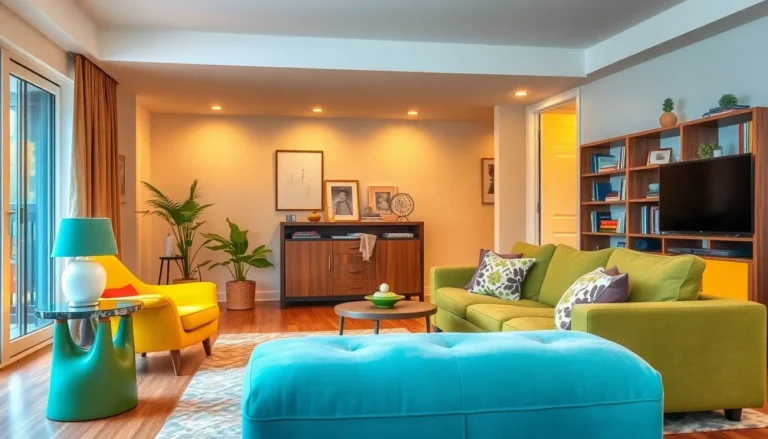Table of Contents
ToggleInterior design isn’t just about picking paint colors and arranging furniture; it’s a magical blend of art and science that transforms spaces into personal havens. Imagine walking into a room that feels like a warm hug or a sleek spaceship—now that’s the power of great design! Whether it’s a cozy nook for curling up with a book or a vibrant living area that sparks joy, the right design can elevate everyday life.
Overview of Interior Design
Interior design encompasses the strategic arrangement and selection of elements within a space. Professionals in this field utilize principles of design, functionality, and aesthetics to enhance environments. Effective interior design integrates color schemes, textures, and layouts to create harmony.
The role of an interior designer extends beyond decoration. They assess clients’ needs, develop design concepts, and execute projects that reflect personal style. This process requires an understanding of architecture, spatial dynamics, and human behavior.
Room layouts play a crucial role. Designers often consider how people engage with spaces, prioritizing flow and functionality. For instance, an open-concept layout can foster social interactions, while defined areas may enhance focus.
Lighting impacts mood and perception significantly. Natural light can make a space feel larger and more inviting, while artificial lighting allows for atmosphere control. Designers often recommend layered lighting solutions to accommodate various activities throughout the day.
Materials and furnishings also contribute to the overall experience. Selection ranges from durable finishes for high-traffic areas to luxurious textiles for intimate settings. Sustainable choices have gained popularity, prioritizing eco-friendly options in modern design.
The impact of interior design on well-being cannot be overstated. Thoughtfully designed environments promote relaxation, creativity, and productivity. Research indicates that well-designed spaces can improve mental health and overall life satisfaction.
Interior design reflects cultural trends and personal tastes. Adapting styles to fit individual preferences ensures each project resonates with its inhabitants. Unique elements, including artwork and personal mementos, personalize spaces, making them distinctive and meaningful.
Key Elements of Interior Design

Interior design encompasses several key elements that work together to create functional and aesthetically pleasing spaces. Understanding these components enhances the overall design process.
Color Schemes
Color schemes significantly impact the ambiance of a space. Designers often choose colors based on the desired mood, with warm hues generating comfort and cool tones promoting calmness. Complementary color combinations can create visual interest and harmony. Neutral colors provide a versatile backdrop, allowing for the inclusion of vibrant accents. Effective color choices are essential for tying together various elements within a room.
Furniture Selection
Furniture selection plays a vital role in interior design. Selecting the right pieces involves considering both functionality and style. Designers evaluate the size and scale of furniture to ensure it fits the space appropriately. Multi-functional furniture can optimize smaller areas, providing flexibility without compromising design. Comfort also remains a priority, as well-chosen pieces enhance the livability of a space. Ultimately, furniture helps define the character of a room.
Lighting Techniques
Lighting techniques influence the atmosphere and functionality of spaces. Natural light enhances visibility while creating an inviting environment; it also connects the indoors with the outdoors. Layered lighting, which combines ambient, task, and accent styles, can enhance specific areas of a room. Adjustable fixtures offer versatility, allowing for changes in mood throughout the day. Thoughtful lighting choices elevate an overall design, enhancing both aesthetics and usability.
Popular Interior Design Styles
Various interior design styles cater to diverse tastes and preferences. Each style possesses unique characteristics that influence space utilization and aesthetic appeal.
Minimalism
Minimalism emphasizes simplicity and functionality. Clean lines and a neutral color palette dominate minimalist spaces. Furniture selection focuses on essential pieces, often featuring organic materials. Clutter-free environments promote tranquility and mindfulness. Natural light plays a crucial role in enhancing minimalist designs, creating airy atmospheres. Decor remains sparse, with only carefully chosen accessories to maintain a sense of calm. Overall, minimalism reflects the idea of “less is more,” fostering an intentional lifestyle that prioritizes well-being.
Bohemian
Bohemian style embraces eclecticism and artistic expression. Rich colors, mixed patterns, and varied textures characterize Bohemian interiors. Layered textiles and handcrafted items contribute to a warm, inviting ambiance. Plant life often appears prominently, bringing vibrancy and life to each space. Personal artifacts and travel souvenirs reflect the inhabitant’s journey, adding depth to the design. This style encourages individuality, allowing people to curate spaces that resonate with their character and experiences. Ultimately, Bohemian design celebrates creativity and personal expression through its unique aesthetic.
Industrial
Industrial design draws inspiration from urban settings and repurposed spaces. It features raw materials like exposed brick, metal, and concrete. Open floor plans and high ceilings contribute to the loft-like feel associated with this style. Furniture often includes vintage or reclaimed elements, enhancing the aesthetic’s authenticity. A muted, neutral color palette complements the rugged characteristics of industrial spaces. Lighting fixtures frequently consist of Edison bulbs or metal designs, adding character and warmth. This style conveys a sense of history while embracing modern functionality and practicality.
The Importance of Space Planning
Effective space planning serves as the backbone of successful interior design. Designers approach each project by assessing spatial dynamics and how individuals interact within environments. They prioritize functionality to maximize the utility of each area while also enhancing aesthetics.
A well-thought-out layout encourages movement and flow, enabling individuals to navigate spaces seamlessly. Room configurations typically consider traffic patterns, ensuring that high-traffic areas remain unobstructed. Thoughtful placement of furniture fosters both comfort and efficiency, allowing occupants to use spaces as intended.
Lighting plays a pivotal role in space planning, defining areas and enhancing overall ambiance. Designers utilize natural light to create a sense of openness, while strategically placed artificial lighting adds layers to the atmosphere. Each element contributes to setting the desired mood within the environment.
Storage solutions figure prominently in space planning, especially in smaller areas. Effective storage designs keep clutter at bay, maintaining a clean and organized look. Each storage option blends functionality with style, often enhancing the overall design narrative.
Collaboration with clients proves essential for successful space planning. Understanding individual needs and preferences allows designers to create environments that resonate on a personal level. Tailored designs ensure every aspect reflects unique lifestyles, whether through flexible layouts or curated furnishings.
Ultimately, the significance of space planning extends beyond mere utility. Well-planned spaces enhance well-being, promoting relaxation, creativity, and productivity. Carefully orchestrated designs enrich daily life, transforming ordinary environments into extraordinary experiences.
Tips for Effective Interior Design
Choosing the right color palette can set the mood for any room. Warm colors like reds and yellows create an inviting atmosphere, while cool colors like blues and greens promote calmness. Selecting furniture with a focus on comfort ensures it meets both aesthetic and functional needs. Multi-functional pieces maximize space while enhancing usability.
Lighting enhances both ambiance and practicality in interior spaces. Natural light should be utilized wherever possible, as it makes rooms feel larger and more inviting. Layered lighting with different sources helps create an atmosphere that suits various activities, from reading to entertaining.
Incorporating textures adds depth and interest to designs. Fabrics, woods, and metals can work together to create a rich sensory experience. Effective space planning remains critical for optimizing layouts. A thoughtful arrangement promotes flow, facilitating movement and comfort within the space.
In addition, personalization plays a significant role in interior design. Including unique artwork and personal mementos imbues a space with character and warmth. Collaborating with clients helps tailor designs to reflect individual preferences, ensuring satisfaction with the final outcome.
Sustainable choices should be considered during material selection. Eco-friendly options not only minimize environmental impact but also promote health and well-being. Lastly, focusing on maintenance and durability guarantees that designs will remain functional and beautiful over time. Evaluating performance alongside style allows for a more practical approach to interior design.
Interior design is a powerful tool that shapes the way individuals experience their environments. By blending aesthetics with functionality, it creates spaces that resonate with personal style while enhancing well-being. The careful selection of colors, textures, and furnishings transforms ordinary rooms into inviting retreats or vibrant workspaces.
As trends evolve, the importance of sustainable choices and thoughtful planning remains crucial. Each design decision contributes to a harmonious atmosphere that reflects the inhabitants’ unique character. Embracing the principles of interior design not only elevates spaces but also enriches daily life, fostering creativity, relaxation, and productivity.





